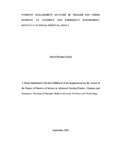| dc.description.abstract | The goal of triage is to prioritize patients who require the most urgent care and increase
efficiency when resources are insufficient to treat all patients as per their degree or grade
of injury. An effective and efficient emergency center triage system should be able to
sort both trauma and non-trauma patients according to level of acuity. It also involves
treatment as per the physiological parameters, either coded as red, orange, yellow, green
or black. Kenyatta National Hospital has adopted the South African Triage Score
(SATS) which has proven to be effective in monitoring the patient’s physiological
parameters, it involves the use of a score form called triage early warning scores
(TEWS). Several studies have found that emergency triage is an effective way to speed
up the triage process, decrease waiting times, and boost patient outcomes in first-world
nations. Low-income or limited-resource situations, on the other hand, present unique
obstacles that might have a substantial effect on the selection and application of the most
suitable triage scale and the success of its implementation. Some of the examples of such
challenges include shortages of material and human resources, poor record keeping
practices, as well as space. The broad objective of the study was to evaluate the outcome
of triaged and coded patients at accident and emergency department, Kenyatta National
Hospital. The study was a cross sectional study involving the triaged and coded patient’s
flagged by scores using the Triage Early warning score (TEWS) whereby structured
questionnaire were used as well as an observation checklist. Study site was accident and
emergency department, Kenyatta National Hospital. The target population were all
coded patients at accident and emergency unit, a sample of 385 patients were used
during this study, data collection was through structured questionnaires and checklist to
assess the healthcare provider and institutional related factors. Pilot study was done at
Kakamega county referral hospital. Data analysis was done using statistical package for
social sciences (SPSS) version 25, descriptive and inferential statistics was used to test
the associated of the factors in relation to the outcomes. Odds ratio was used to test the
strength between the provider and health facility factors associated with the management
outcome of triaged and coded patients, a one-way analysis of variance was be used to the
differences in mean scores in the institutional and provider factors. Data was presented
in tables and bar graphs. The study results indicated that patient related factors had
significant influence on management outcome of triaged patients’ (t-statistic=.210, pvalue
= 0.039 < 0.05). The other findings revealed that provider related factors had
significant influence on management outcomes of patients triaged (t-statistic=13.055, pvalue=
0.002< 0.05). Further study results indicated that there was a positive and
significant relationship between institutional related factors and management outcome of
triaged patients’. This is depicted by a Pearson correlation coefficient r=0.452 p-value
=0.008< 0.05 which was significant at 0.05 level of significance. This implies that
improved institutional related factors result in an increase in management outcome of
triaged patients’. It’s therefore important to note that patients related factors, provider
related factors and institutional related factors have an impact on the outcome of triaged
and coded patients in accident and emergency department, Kenyatta national hospital.
Thus, it’s important for the institution to invest in human resource capacity, procurement
of equipment and drugs to be used as well as improve on infrastructure. Further research
to be done to determine the patient satisfaction levels as well as the staff training needs
assessment. | en_US |

